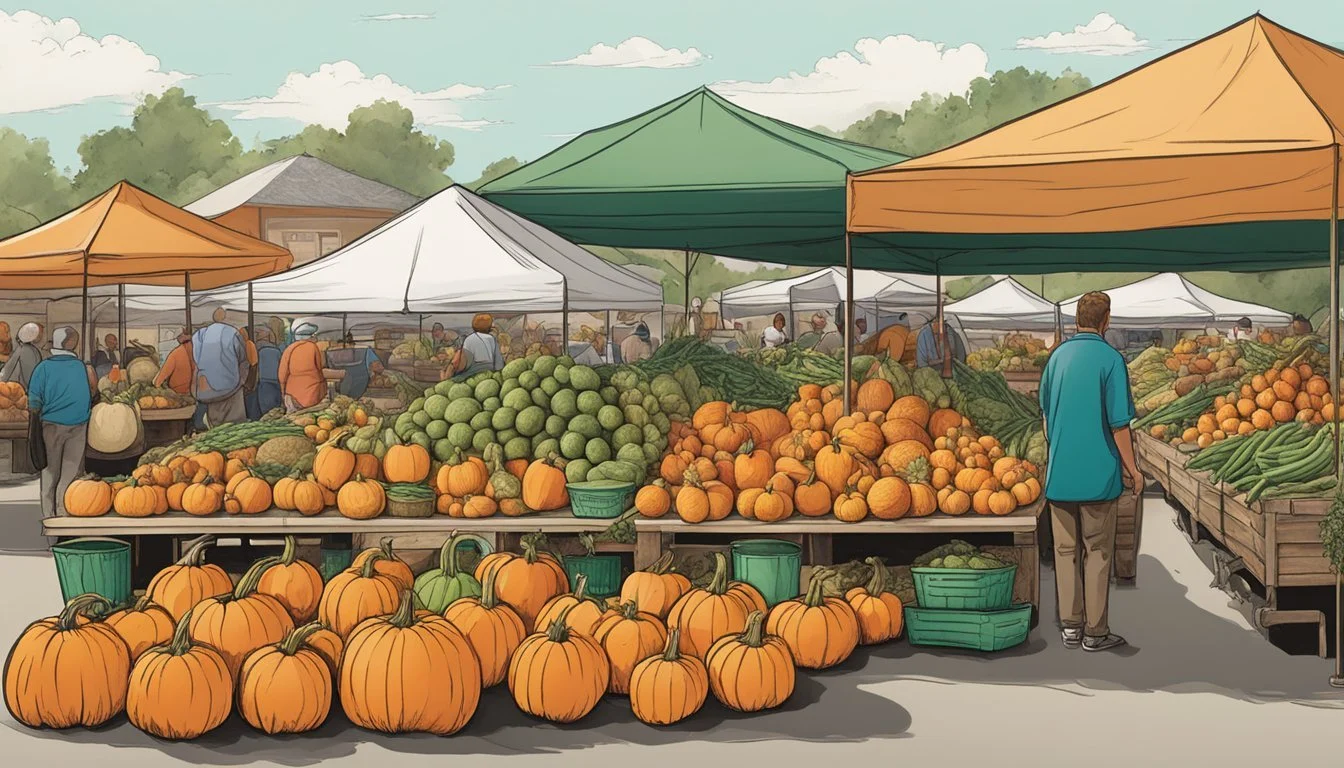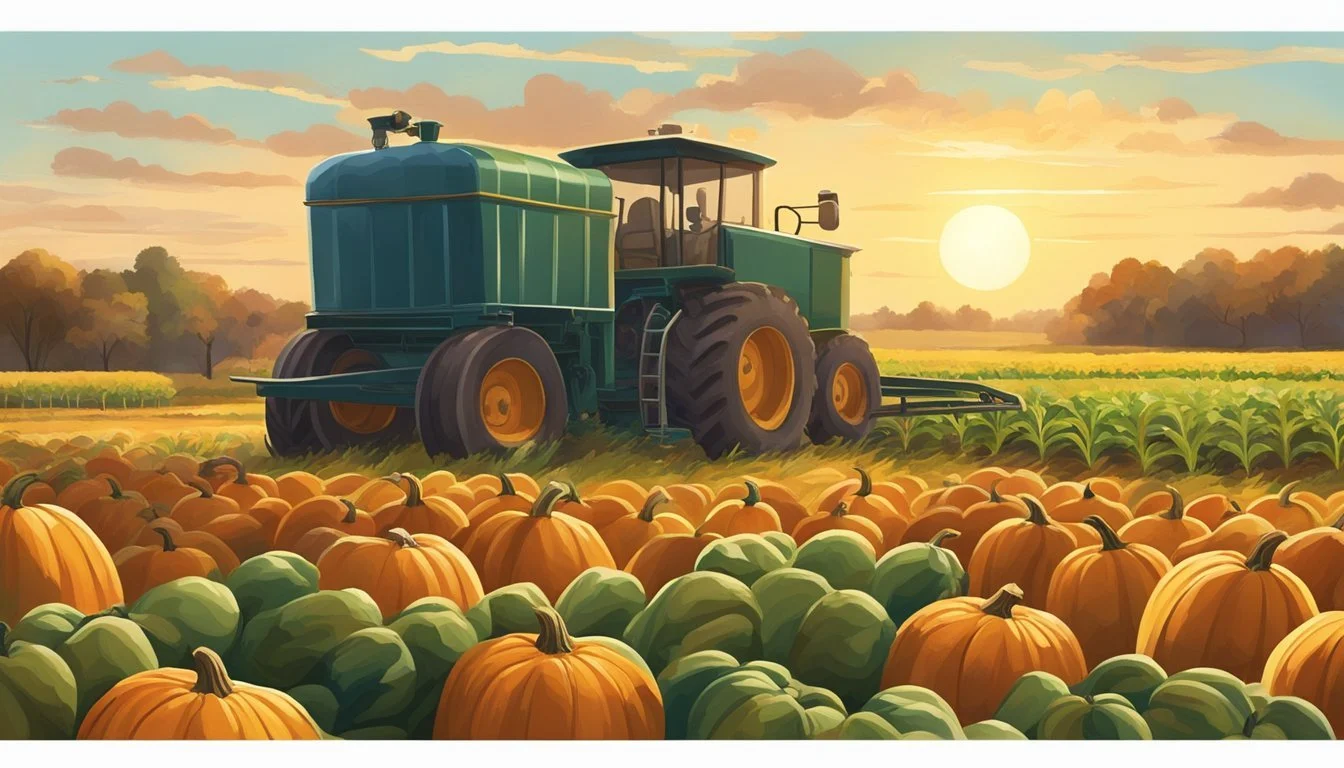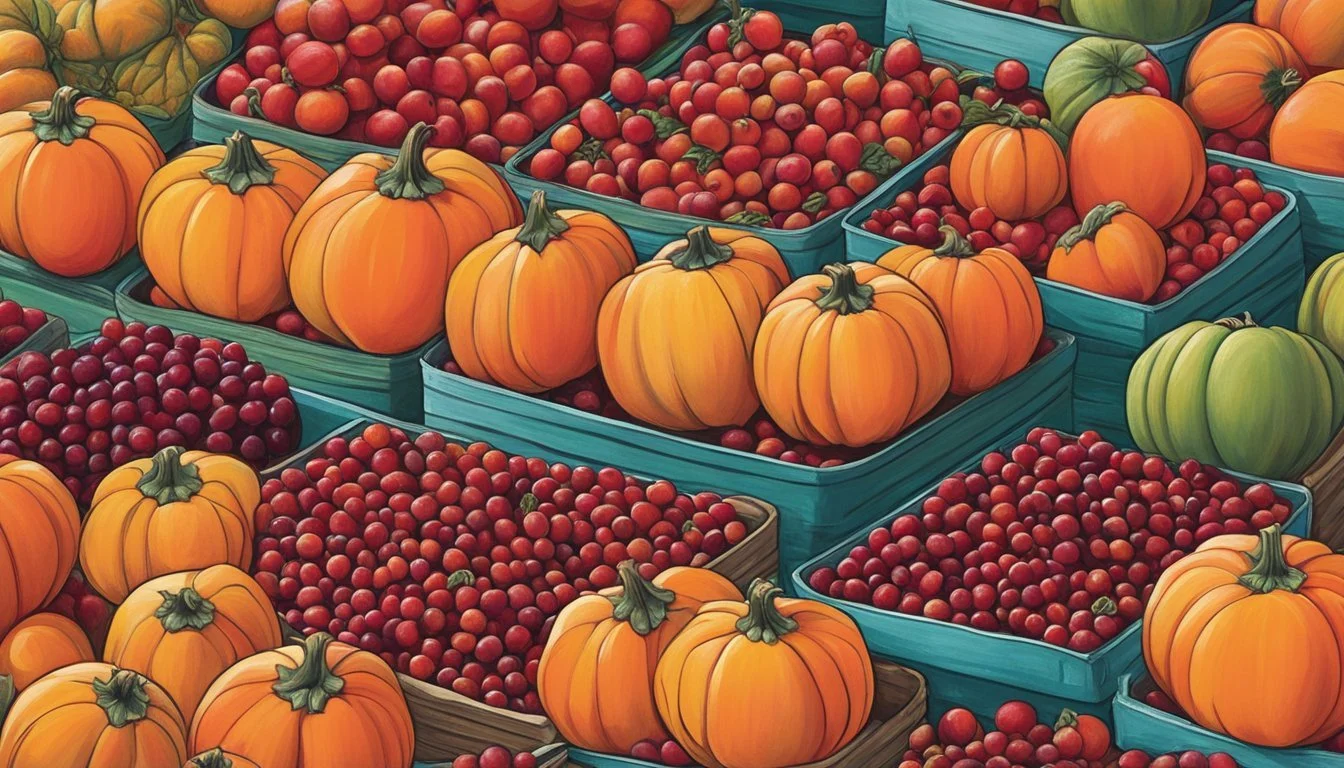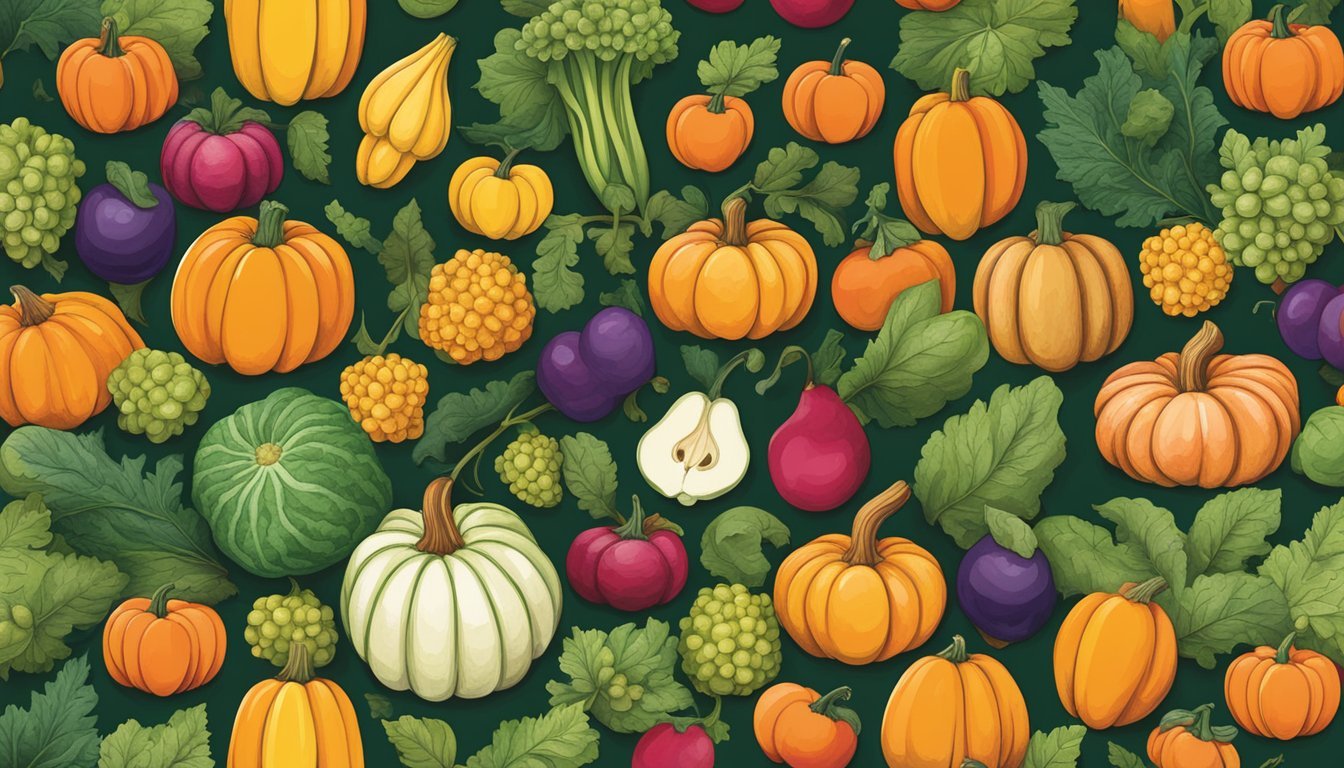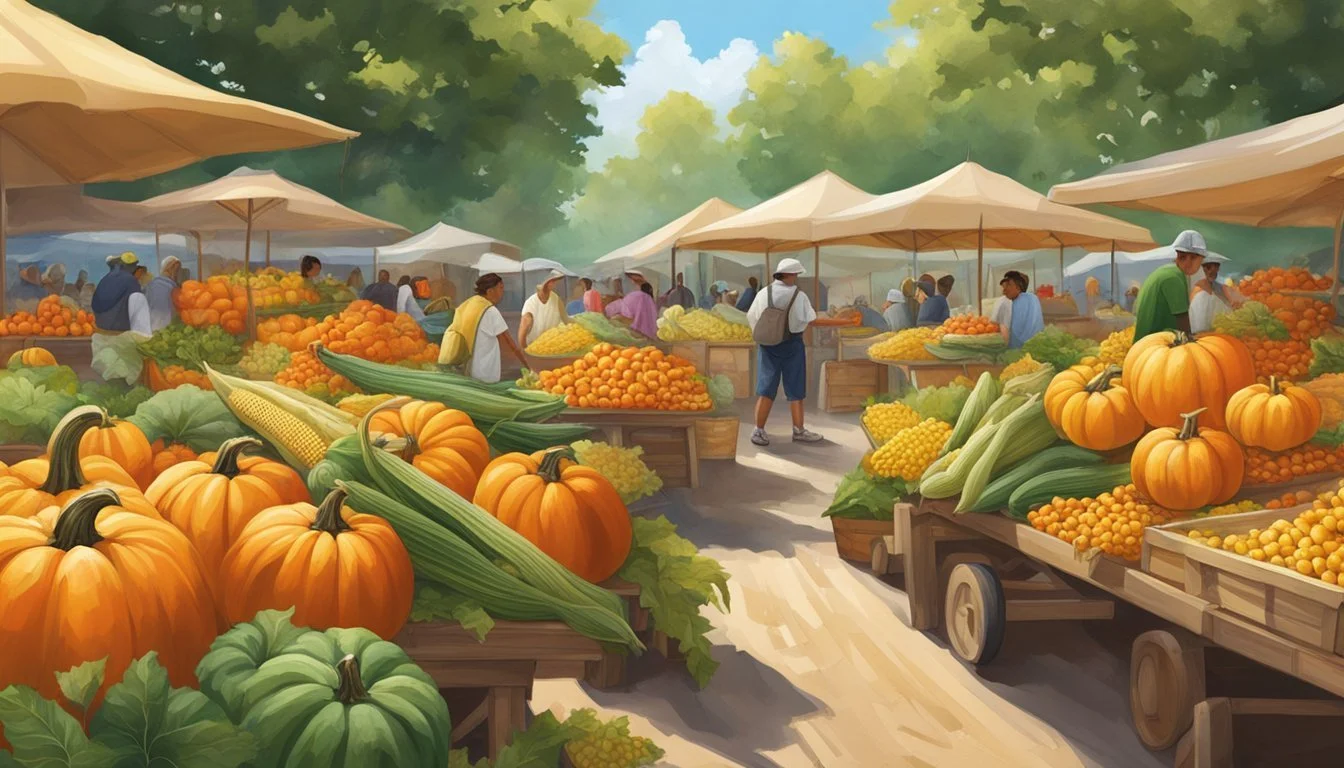Louisiana Seasonal Fruit & Vegetables in October
Your Guide to Autumn Harvest
This Article is Part of our Louisiana Seasonal Fruit & Veg Calendar
Discovering seasonal fruits and vegetables in Louisiana for the month of October provides an insightful peek into the state's agricultural richness. During this month, Louisiana's fields and orchards are teeming with a variety of produce that captures the essence of fall. The cooler weather ushers in a bounty that includes robust root vegetables and a selection of fruits that signal the transition from summer's sweetness to autumn's depth of flavor.
October's seasonal produce in Louisiana is not limited to the popular pumpkins that grace many a doorstep during this festive month. The state’s harvest also includes vibrant radishes, including large varieties such as the daikon and the visually striking watermelon radish. Louisiana's fertile soil yields a diverse harvest that also comprises sweet potatoes, a staple in many Southern cuisines and a versatile ingredient for both savory and sweet dishes.
Integrating these seasonal foods into culinary endeavors not only supports local farmers but also ensures peak freshness and nutrition. Consuming local produce from Louisiana during its prime month of October can lead to more delicious and nutritious meals, reflecting the agricultural heritage and gastronomic diversity of the region.
Louisiana's Climate and Harvest Seasons
October in Louisiana heralds the peak of the fall season, a critical time for harvesting a variety of produce shaped by the state's unique climate.
Understanding Louisiana's Fall Season
Louisiana experiences a subtropical climate, with long, hot summers and short, mild winters. Fall in Louisiana is characterized by a gradual decrease in temperature and humidity, making it an ideal time for the culmination of many growing cycles. The weather transition typically allows for an extended harvest period into fall, particularly in October. This is when many crops reach maturity and are harvested before the onset of cooler winter temperatures.
Optimal Harvesting Times
The optimal times to harvest certain fruits and vegetables are greatly influenced by the state's fall conditions. For instance:
Clementines: These citrus fruits normally begin to ripen around October.
Eggplant (how long does eggplant last?): Harvesting can last until early October.
Figs: The season typically ends in early October.
Collard Greens (how long do collard greens last?): These are often available until June, benefiting from the relatively mild fall climate.
Sweet Corn: Harvesting typically concludes by the end of fall.
October's cooler nights and still-warm days provide a prime environment for these crops to thrive. Louisiana's farmers carefully monitor the seasonal cycles to determine the best times to pick each fruit and vegetable, ensuring peak freshness and flavor.
Fruits to Enjoy in October
Louisiana provides a variety of fresh fruits in October, with an emphasis on citrus and late-season harvests that bring both sweet and tart flavors to the table.
Citrus Fruits
October marks the arrival of early citrus fruits in Louisiana. Gardeners and consumers can look forward to vibrant clementines, although they are typically just starting to come into season toward the end of October.
Berries & Grapes
While berry season is nearing its end, one can still enjoy the last fig harvests, which typically stretch into early October. These fruits maintain their delicate sweetness and are highly anticipated in local markets.
Tree Fruits
Several tree fruits are at their prime during this month. Persimmons are notable for their sweet, honey-like taste and are ripe for picking. Additionally, apples (how long do apples last?) and pears, with their crisp texture and versatility, continue to be available and are a favored choice for autumn recipes.
Exotic and Tropical Fruits
Though Louisiana's climate is more temperate, October is still ample time to enjoy exotic varieties such as pomegranate. Their distinctive tart seeds add a burst of flavor and are commonly used in savory dishes, desserts, and drinks.
Each fruit listed provides unique flavors and health benefits, contributing to the variety of options consumers have to enjoy. Whether eaten fresh, included in a baked dish, or preserved for later use, Louisiana fruits offer something special to savor during the month of October.
Vegetables in Season
In Louisiana, October marks a month where a variety of vegetables reach their peak, offering a bounty of flavors, textures, and nutrients. The cooler temperatures support a diverse harvest from crisp root vegetables to lush leafy greens and robust nightshades and gourds.
Root Vegetables
Sweet Potatoes: They are a staple of the October harvest in Louisiana. With their sweet, earthy flavor, they are versatile for a range of dishes from baked goods to savory sides.
Other Root Vegetables: Beets (how long do beets last?) and turnips also thrive in October. Their robust flavors are excellent for roasting or as additions to hearty stews.
Leafy Greens
Kale: This nutrient-dense leafy green is at its best in cooler temperatures, ensuring a tender and slightly sweet flavor.
Spinach: Another cool-season favorite, spinach’s vibrant leaves are perfect for salads or as a cooked green.
Nightshades & Gourds
Tomatoes: While reaching the end of their season, tomatoes in October can still be found, adding bright notes to dishes.
Pumpkins: Synonymous with fall, pumpkins are more than just a Halloween staple; they're also a nutritious and flavorful addition to meals.
No other information given about vegetables in the search results applied to the vegetables in season for October in Louisiana, only the mentioned ones are in season according to the provided snippets.
Nutritional Benefits of Seasonal Produce
Eating seasonal produce in Louisiana provides a rich intake of essential nutrients, as fruits and vegetables available in October typically contain high levels of fiber, vitamins, and antioxidants. These components are vital for maintaining a balanced diet and promoting overall health.
Fiber found in seasonal fruits and vegetables aids digestion and can help maintain healthy cholesterol levels. Seasonal produce like sweet potatoes and pumpkins are excellent sources of dietary fiber.
Vitamins are abundant in seasonal produce. For example, tomatoes, whether field or greenhouse-grown, are rich in vitamin C and vitamin K. The fall season also sees an increase in the availability of carrots which are known for their beta-carotene, a precursor to vitamin A, essential for good vision and immune function.
Antioxidants play a crucial role in protecting the body from oxidative stress and may reduce the risk of chronic diseases. Winter squash varieties such as acorn and butternut squash (how long does butternut squash last?) offer antioxidants like vitamin E and beta-carotene.
Incorporating a variety of these seasonal fruits and vegetables into one's diet ensures a wider range of nutrients and helps adhere to dietary recommendations. For instance, adults should aim for 1.5-2 cups of fruits and 2-3 cups of vegetables each day, as they contribute to a nutrient-rich diet and can help in reducing cancer risks.
Louisiana's seasonal offerings align with a nutritious diet that supports health and wellness, making every meal an opportunity to benefit from the bountiful autumn harvest.
Freshness and Ripeness Indicators
Selecting the freshest and ripest fruits and vegetables in Louisiana during October requires attention to visual cues, texture and firmness, and aroma and flavor. These indicators can significantly impact both the taste and nutritional value of the produce.
Visual Cues
The colors of October produce should be vibrant and deep, indicating peak ripeness. For example, sweet potatoes exhibit a rich orange skin when they are ripe. Pumpkins should possess a consistent orange hue without green spots. Eggplants appear with a glossy deep purple skin, while peppers range from bright green to vivid red or yellow, depending on the variety.
Texture and Firmness
Ripe produce often has a specific firmness that suggests peak readiness for consumption. Persimmons should yield slightly to pressure, indicating that they are ripe enough to eat. On the other hand, firmness in apples and pears—also in season—suggests that they are fresh and have been recently harvested.
Aroma and Flavor
A strong, pleasant aroma is often a hallmark of ripe fruits and vegetables. Figs, for example, should smell sweet and be slightly soft to the touch, suggesting they are at the pinnacle of their flavor. Satsumas, a type of citrus, will exude a sweet, tangy scent, and their skin will be slightly loose, indicating they are ripe for enjoyment.
Culinary Uses and Recipes
October's produce in Louisiana inspires a varied culinary landscape. The ingredients are used in an array of dishes from fresh salads to comforting stews.
Salads and Raw Preparations
The crisp, cool weather of October in Louisiana brings a variety of produce that can be enjoyed raw. Salads are a perfect way to showcase the freshness of the season.
Collard Greens: These leafy greens can be thinly sliced and used in a raw salad with a punchy vinaigrette.
Cucumbers: They make for refreshing salads, often paired with a simple dressing of oil, vinegar, salt, and pepper.
One can create a colorful and healthy salad using roasted beets with a tangy citrus dressing, highlighting the sweetness of the beets against the acidity of the dressing.
Cooking Techniques for Vegetables
Cooking techniques play a crucial role in unlocking the flavors of vegetables available in this season.
Roasted: Vegetables such as eggplant and garlic can be roasted to concentrate their flavors. Eggplants can be transformed into a smoky sauce or side dish.
Sauteed: Quick and high-heat methods like sautéing help in retaining the natural crispness and nutrients of vegetables.
Braised: Heartier greens like collards are well-suited to being slowly braised in a flavorful liquid until tender.
Simple recipes might involve sautéed corn with herbs and garlic used as an accompaniment to a main course.
Desserts and Preserves
The end of summer and early fall fruits make for excellent desserts and preserves.
Figs: These are often turned into jams or preserves, or even baked into fig bars.
Stone fruits: Peaches and plums can be baked into warm, spiced crisps or cobblers.
A popular dessert consists of roasted stone fruits topped with a dollop of whipped cream or folded into oatmeal or yogurt.
Preservation and Storage Tips
For keeping the seasonal produce of Louisiana fresh, understanding proper storage and preservation methods is essential. Each fruit and vegetable has its optimal storage conditions, which will significantly extend its shelf life and maintain the quality.
Fruits:
Citrus Fruits: Clementines and figs should be stored in a cool, dry place, or in the refrigerator to prolong freshness.
Apples: They last longer when kept in a crisp drawer of the fridge, away from vegetables.
Vegetables:
Collard Greens: These leafy vegetables are best kept in the refrigerator, wrapped in a damp paper towel inside a perforated bag to maintain moisture.
Root Vegetables: Carrots, parsnips, and rutabagas should be stored in a cool, dark place or in the refrigerator. Dirt left on the roots can help prolong shelf life.
For drying (dehydrating):
Many seasonal fruits and vegetables can be dehydrated to extend their usability. This can be done with a dehydrator or in an oven at a low temperature.
Method Produce Notes Refrigerate Citrus, Apples In fruit drawers, away from vegetables Cool Storage Root vegetables In the dark, can be left unwashed Dehydrating Figs, Apples Use dehydrator or oven at low temperature
Remember: It's vital to consume dried fruits in moderation as they are more calorie-dense than their fresh counterparts. Ensure proper sealing and storage to avoid moisture and prolong shelf life.
Supporting Local Agriculture
Louisiana's local markets become vibrant in October with a plethora of fresh, sustainable produce available to consumers. Visiting local farmers markets not only supports the livelihood of small-scale farmers but also contributes to sustainable agriculture practices. Buying local means investing in the community and ensuring the preservation of diverse crop varieties that are often unique to the region.
Why Buy Local?
Economic Support: When people purchase directly from local farmers, they help to sustain the agricultural community and the local economy.
Sustainability: Shorter transportation distances for produce mean a smaller carbon footprint and fresher goods on the table.
Community Health: Locally-grown food, being harvested at peak ripeness, can lead to more nutritious options for families.
By the month of October, certain crops are in peak season. Consumers interested in locally grown produce can look for the following items:
Vegetables: Collard Greens, Cucumbers
Fruits: Clementines, Figs
Additional Harvests: Garlic, Fennel (how long does fennel last?)
To further support local agriculture:
Visit nearby farmers markets.
Join a community-supported agriculture (CSA) program.
Look for "locally grown" labels in grocery stores.
Frequenting farmers markets or participating in a CSA also fosters a connection between the consumer and the grower. It allows individuals to become more informed about where their produce comes from and the agricultural techniques used in their cultivation. This knowledge can reinforce consumer trust and a sense of community around the shared goal of maintaining a sustainable local food system.

